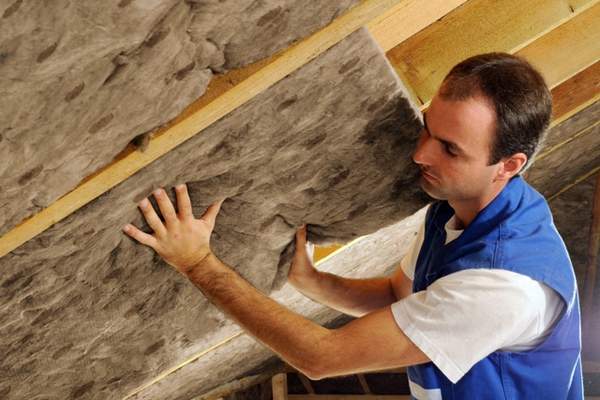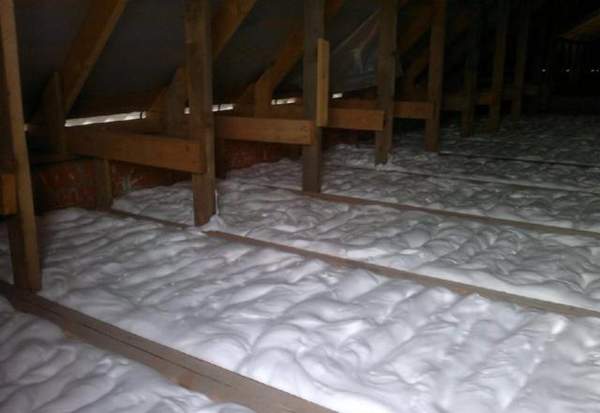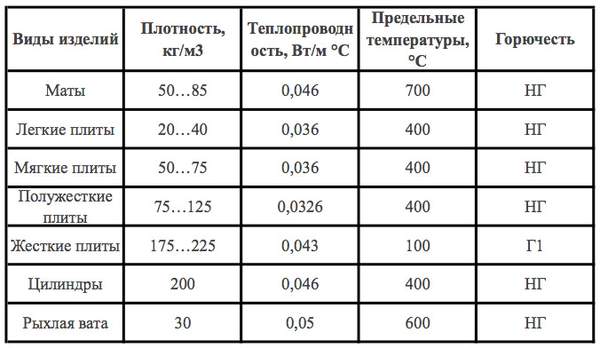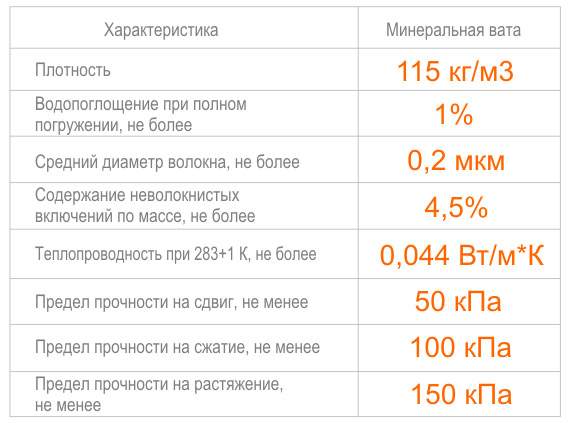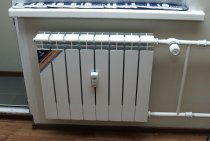How to apply mineral wool
When using mineral wool as a heater, one should strive to choose the optimal density of the boards based on the object of insulation, as well as information on the compaction coefficient provided by the manufacturer. When preparing a professional project for insulation, complex calculations are used, but in practice, when insulating their houses, their owners act more on a whim.
Mineral wool is produced in the form of mineral mats, mineral felt, semi-rigid and rigid boards.
Characteristics of mineral wool insulation.
Mineral mats are a piece of mineral wool carpet, which is enclosed on both sides in bituminized paper, fiberglass or a special metal mesh, and stitched with a strong thread for better fixation. Mineral mats have standard dimensions of 50x150 cm, their thickness can vary from 2 to 10 cm, and their density can vary from 100 to 200 m³
Such mats are used mainly in industry, for thermal insulation of equipment and pipes, since their dimensions make it possible to insulate pipes of various diameters. Such mats withstand temperatures of 400°C, and on a metal mesh base - up to 600°C without any damage to their thermal insulation properties. Due to their large size, mats are rarely used for warming private houses.
Mineral felt is available both in sheet and roll form. Wool in felt is impregnated with synthetic resins, which significantly improves its thermal insulation qualities. Its density becomes 75-150 kg / m³, and thermal conductivity - 0.046-0.052 W / (m-K).
For the production of semi-rigid boards, synthetic resins or bitumen are sprayed onto the mineral fiber, and then it is pressed and dried. The density of such boards depends on the compaction force and ranges from 75 to 300 kg/m³. The dimensions of the plates are 60x100 cm, the thickness can reach up to 20 cm. Plates with synthetic fillers can be used to insulate structures with temperatures up to 300 ° C, and on a bituminous binder - no higher than 60 ° C.
Scheme of production of mineral wool.
Mineral wool rigid boards are obtained by mixing mineral wool with synthetic resins and then polymerizing and pressing it. The density of such plates is in the range from 100 to 400 kg / m³, the dimensions are the same as for semi-rigid ones, 60x100 cm (thickness - from 4 to 10 cm).
Each of these types has its own purpose. Mineral felt and mineral mats are mainly used for insulation of engineering communications (pipes) of various diameters, as well as horizontal planes (floor, ceiling).
Semi-rigid and rigid boards are used to insulate both horizontal and inclined planes (slopes and decorative elements), and rigid boards, due to their rigidity, are used to insulate vertical wall planes.
Thermal conductivity coefficients
All durable components are gradually heated, and after cooling, observing the intervals, the temperature regime of the internal structure and the surface of the material. The thermal insulation qualities of mineral wool are demonstrated by the coefficient of thermal conductivity. Its smallest value provides the maximum preservation of thermal conductivity. Often, the coefficient values are pre-specified by the manufacturer. The value of the coefficient is determined in laboratory conditions.
Thermal conductivity values vary around 0.032 W/(m*K). The latter indicator is found only in high-quality heaters.
The use of cotton wool of different densities for insulation
The choice of insulation according to the indicator under consideration depends on the place of its use. It is not always necessary to overpay in order to get the desired result.Most often, the facade, walls, roof and floor are insulated. These are the options worth considering.
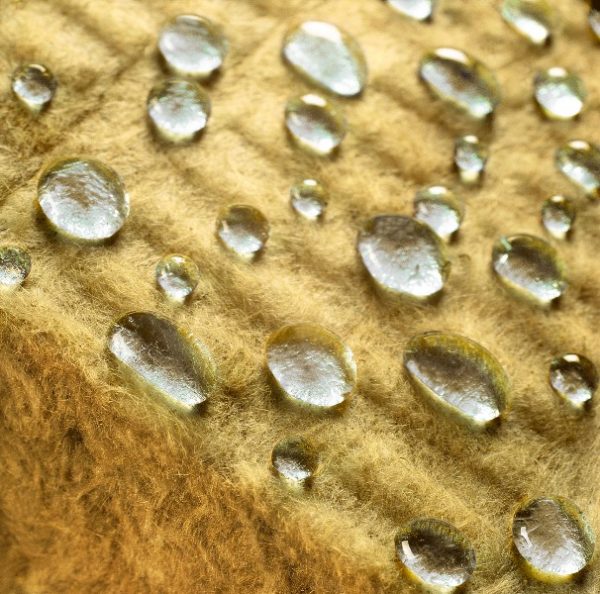
Facade
When choosing insulation for the facade, you need to pay attention to the mass and density of mineral wool. For most buildings, weighting is very undesirable.
It is also worth paying attention to the possibility of subsequent finishing, because the indicator in question also affects this. So:
- If the facade is equipped with ventilated, then sufficient density is 45-100 kg m³. Here, cotton wool is laid in the crate and there will be practically no load. The main tasks for this type are to keep in shape and not settle under their own weight, and the indicated indicator is enough for this.
- If the facade is plastered over the insulation, then the density should be above 100 kg m³, optimally from 145 to 165. This will allow the use of any type of plaster mixes, including bark beetle, barenki and even mosaics. Since this mineral wool will have to withstand heavy loads during installation, it must be securely fixed for this, a system with dowels in combination with adhesive fastening is used.
Wall insulation
In this case, the selection is carried out according to the ease of installation, that is, the density should be at least 30-45 kg m³. At the same time, it is necessary to insulate from the inside, MDF boards or drywall should be wound on top of the material. In order to mount such a mineral wool, you need a crate, rolls or sheets are laid into it.
Roof
Since roof insulation works are carried out at a height, the main criteria for choosing mineral wool are light weight and ease of use. These qualities can please a material with a density of 30-35 kg m³. Its sound and heat insulation properties will be excellent, and at the same time light weight. Installation can be carried out in two ways:
- With the help of a construction stapler.
- In a crate with a vapor barrier.
In both the first and second cases, it is necessary to close the insulation on top with a finishing material.
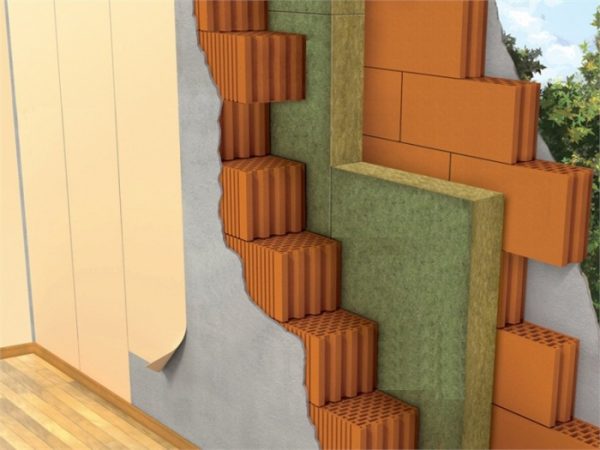
The selection of mineral wool in this case depends on the type of floor finish. So, if these are sheet materials, such as solid board, laminate, etc., then a density of more than 30-45 kg m³ is not needed. After all, there will be no pressure on the cotton wool, it fits between the lags.
But now manufacturers offer material with an indicator of 200-220 kg m³, such wool can be mounted on a base and poured over with a cement screed. Of course, the price of such material is quite high, but the ease of handling is the highest possible.
Types and selection
In general, all insulators can be divided into the following groups:
- dense - mineral wool under high pressure;
- medium - glass wool and polystyrene foam;
- lungs - mineral wool;
- very light - foam boards.
To determine the type of insulation, you need to consider some factors.
For finishing in a residential building
So, for finishing walls and floors in a residential building, it is better to use basalt materials, which differ not only in optimal density, but also in environmental friendliness. For basalt fiber, it can be different: for walls with siding, it is better to use a material with a unit mass per unit volume of at least 40 and not more than 90 kg / m3. This indicator should grow with the growth of the building: the more floors, the greater the rigidity.
Materials of 140-160 kg/m3 are suitable for plastered facades. Most often, special elements with high peel strength and vapor permeability are used. When insulation outside the house is not possible, then the procedure is carried out from the inside - density also affects here, insulators with its low index are needed. In both cases, mineral or fiberglass is suitable.
For roof and floor finishing
Thus, roofing insulation boards should be of low specific gravity. But it depends on the type of roof:
- a pitched roof requires slabs of 25-45 kg / m3;
- for the attic, materials with a pressure of at least 35 kg / m3 are needed;
- a flat roof needs insulators that can withstand good mechanical loads - snow and wind, so basalt wool with 150 kg / m3, polystyrene foam with an indicator of more than 35 kg / m3 are suitable.
Extruded polystyrene foam is used for thermal insulation of the floor. If the insulation is carried out on logs, then mineral wool slabs can be used - rigidity does not really matter, because the beams will take on the pressure. Plates of 50 kg / m3 are installed in the interior walls.
Penoizol and polyethylene
Penoizol has one significant difference from previous insulators - it is applied in liquid form and has a low density of 10 kg / m3, while its high porosity gives it good insulating properties. Foamed polyethylene can be with different specific gravity - it depends on the presence of reinforcement and thickness:
- rolled material is needed for floor insulation - 24 kg / m3;
- for frame structures and insulation of refrigeration units, engineering structures, it has reinforcement with aluminum sheets -50-60 kg / m3.
Foam glass
So, foam glass has a thermal conductivity of 0.1 W and is much stronger than other heaters. The density index reaches 400 kg/m3 and the material is very stable - suitable for external thermal insulation without requiring a protective layer. Cellular glass has a wide range of materials:
- external insulation - 200-400 kg / m3;
- vertical structures - 200 kg / m3;
- roofs and foundation - 300-400 kg / m3;
- for light and frame structures - 100-200 kg / m3.
Thermal conductivity is 0.04-0.06 W and is almost similar to mineral heaters.
Mineral wool in rolls types and sizes
A wide variety of various innovative thermal insulation materials is presented on the modern market. This is a liquid-ceramic heat insulator, and polyurethane foam, and silica mats. However, mineral wool is still the most popular of them.

Rock wool rolls are commonly used to insulate horizontal surfaces. This laying requires careful handling and avoiding too much stress on the surface. With the help of rolls, floors between floors, floors, attics, roofs with a slight slope are isolated. With their help, pipes, fireplace covers and home stoves are also insulated.
Roll dimensions (width, thickness, length in mm):
- Ursa M-11 - 1150 for 53 for 9000;
- Isover Classic - 1220 by 50 by 8200;
- Isover Sauna - 1200 for 50 for 8200;
- Heat Knauf Dacha - 1220 to 50 to 7380.
Volumetric mineral wool is inconvenient to fold, so usually its thickness does not exceed 50 mm. Mineral wool in rolls can be used to insulate rooms with a large area, in which the surface is subjected to significant stress. Logs, rafters and other building elements are usually used for laying rolls.
Brief description of the material
Wool for wall insulation is the best price-quality ratio when creating comfortable living conditions. It consists of a large number of fibers, which are obtained by a specific processing method. They can be made of glass, slag, stone. The density of any mineral wool, measured in kg per m3, also depends on the material of manufacture. Insulation has a number of advantages, among them:
- Ease of installation. Mineral wool can be presented in the form of a roll or plates that hold the shape.
- The light weight of the material, which allows it to be used for floors, without weighing them down.
- Convenience of subsequent finishing. This indicator depends, among other things, on the density of the insulation.
- Environmental friendliness - mineral wool is created from natural materials, which allows it to be completely safe.
- The material is a good sound insulator.
- Incombustibility - it melts, but does not burn.
There are also disadvantages and they should be taken into account when insulating with mineral wool:
- Glass and slag wool are very prickly, this must be taken into account during the installation process. Stone wool is practically free from this disadvantage.
- The material, together with air, passes moisture, which leads to the loss of its technical characteristics. To avoid this, it is necessary to isolate the insulation from moisture.
- To buy high-density mineral wool, you will have to spend a lot of money, but the result will exceed expectations.
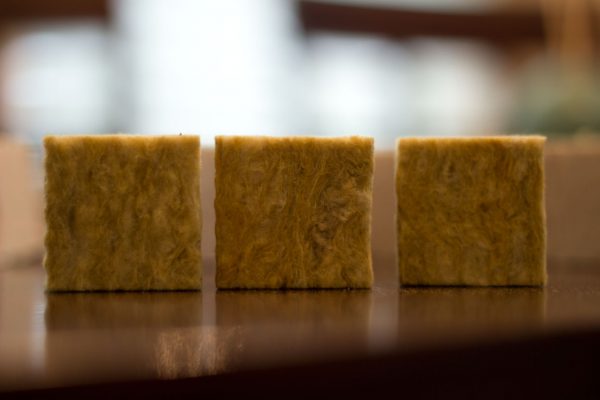
The use of mineral wool with different densities
Mineral wool with a density up to 35 kg/m 3 can only be used for unloaded horizontal surfaces. Basically, this type of insulation is produced in the form of rolls, which are rolled out over the surface and attached to it.
Scheme of thermal insulation of the facade with mineral wool.
For mineral wool used for insulation of internal floors, ceilings and internal interior partitions, the density index should be within 75 kg / m 3. The same indicator will be for semi-rigid slabs used to insulate walls and ceilings of non-residential and technical premises.
For ventilated exterior walls, the density will be up to 100 kg/m. The density of the insulation used for facade insulation should be within 125 kg / m 3. In both cases, the density is indicated on the condition that additional wall decoration will be carried out: in the first case, with siding or a similar type of insulation, and the second implies subsequent wall plastering.
For interfloor reinforced concrete floors, the density of mineral wool should be up to 150 kg / m 3, and for load-bearing reinforced concrete structures, it increases to 175 kg / m 3.
For floors under the screed, in the event that the thermal insulation acts as the top layer of the coating, the density of the insulation will be up to 200 kg / m 3. The same density should be for mineral wool slabs that insulate the roof and attic. Such plates are able to withstand loads up to 12 MPa.
When choosing a mineral wool insulation, you need to remember that plates with a higher density have a lot of weight, and take this into account when constructing a frame for their installation. Also, do not forget that any mineral wool insulation, regardless of its density, additionally needs wind protection and waterproofing.
Knowledge is also money. Therefore, in order not to spend your money on a poor-quality or insufficient thermal insulation device, do not be too lazy to spend a little time and get acquainted, at least in basic terms, with the technological characteristics of the material you have chosen for insulation. This will be your best guarantee that you will not get into a mess later on.
Warmth and comfort to your home!
Specific gravity of various types of thermal insulation
Density indicators differ not only depending on the type of insulation, but also on the type of different modifications of the same material. The manufacturer must specify the following parameters: volumetric weight of insulation , which corresponds to the density of the material and the weight of the insulation package.
Embodied carbon
Embodied carbon is usually thought of as the amount of gases emitted from normally fossil fuels and is used to generate energy expended between the extraction of raw materials, through the production process to the factory gate. In fact, of course, it is much more than transportation to the site, the energy used in the installation, for demolition and destruction.
The science of embodied carbon is still evolving - hence it is difficult to get reliable and reliable data. Vapor permeability is the degree to which a material allows water to pass through it. Thermal insulation is usually characterized as vapor permeable or vapor permeable.Often referred to, erroneously, as "Breathing Structure", walls and roofs, so-called, are characterized by their ability to transport water vapor from the inside to the outside of the building, which reduces the risk of condensation.
Mineral wool dimensions
Manufacturers represent 3 types of mineral wool, each of which has its own type of raw material, namely
3. Basalt mineral wool.
All types are successfully used for hydro and thermal insulation of various residential and industrial buildings. For a more comfortable installation, manufacturers produce products of various sizes and shapes.
Mineral wool rolled up is produced in the form of a large billet, pre-cut and assembled. The dimensions of the material are indicated on the packaging, as they are different for many manufacturers. Thickness can vary from 40 to 200 mm, width from 565 to 610 mm, length about 1170 mm. The thickness of rigid plates for hydro and thermal insulation varies from about 50–170 mm, the width of the product is about 1190 mm, and the length is -1380 mm.
Mineral wool in this format is ideal for thermal insulation of large areas, as the rolls contain a large amount of material. As a rule, the width of the materials varies between 50–200 mm, the length of the sheet is about 7000–14000 mm, and the width is approximately 1200 mm. The material is easy to cut and fit to the size of the room.
Mineral wool in cylinders
Designed for waterproofing hydraulic lines. The basis of this type of mineral wool includes: foil, fiberglass and basalt. The structure withstands high temperatures up to 250 C. The width of the product mainly varies between 12–324 mm, the length is about 1200 mm, and the thickness is 20–80 mm. The exact dimensions are painted on the packaging of the material. Mineral wool in cylinders is intended for thermal insulation of heat exchange systems and heating communications. Diameter, thickness and length are selected in accordance with the size of the pipes
The mass of mineral wool varies depending on the substances filling it
To determine what weight the builder will be dealing with, you should pay attention to the density of the material, which can also be found out as the mass of mineral wool at the rate of 1 cubic meter. This figure can vary from 35 to 100 kg per 1 cubic meter.
The mass of insulation boards is on average 0.6 vkm. In the process of performing technical operations, weight does not play a significant role.
Manufacturers' products have different weights, on average, this figure varies from 37 to 45 kg with dimensions not exceeding 1.35 kg, and depends on the density of the heat-insulating material. Its weight changes significantly with a combined approach to insulation. In this case, the thickness of the insulation used is of decisive importance.
Stone wool has a fibrous structure resembling basalt in composition. It is considered a natural material, 80 percent consists of the earth's crust, and cotton wool itself is made from melts of volcanic rocks.
Balzac fiber is produced in the factory, but its composition is also similar to the chemical structure of rocks. It also contains sand, soda, limestone, borax and dolomite. In finished form, the material has impressive dimensions and is permeated through with air. For storage and transportation, mineral wool is compressed up to a sixfold state.
Many manufacturers are trying to improve the quality of the product by making changes to the composition and production process. To increase rigidity, the plates are stitched, impregnated with bitumen and phenols with the addition of asbestos. If the composition contains additional substances, this may change the characteristics of the product. Bitumen prevents damage by insects and fungus, protects the product from moisture and provides additional strength.
The official standard applies to stone wool made from substances of rocks of the gabbro-basalt group, as well as their identical substances, sedimentary rocks, volcanic, metallurgical residues, industrial silicate slags, alloys intended for the production of heat-insulating, sound-proofing and sound-absorbing materials.
Stone wool can be used as a heat-insulating substance in the construction industry and industrial production for surface finishing with a temperature regime of -180 C to +700 C.
Types of mineral wool
All types have good fire resistance.The most popular are glass and mineral wool. The basis of stone mineral wool contains rocks of basalt groups with an admixture of metallurgical substances. The structure of glass wool is filled with fiberglass, using quartz sand and old glass substances.
In 2 cases, phenol-formaldehyde resin is used as a binder. According to research, this substance can harm human health. But in comparison with the popular chipboard material, which has the same resins in its composition, its amount is 20 times less.
Compound
Stone wool has a fibrous structure resembling basalt in composition. It is considered a natural material, 80 percent consists of the earth's crust, and cotton wool itself is made from melts of volcanic rocks.
Balzac fiber is produced in the factory, but its composition is also similar to the chemical structure of rocks. It also contains sand, soda, limestone, borax and dolomite. In finished form, the material has impressive dimensions and is permeated through with air. For storage and transportation, mineral wool is compressed up to a sixfold state.
Many manufacturers are trying to improve the quality of the product by making changes to the composition and production process. To increase rigidity, the plates are stitched, impregnated with bitumen and phenols with the addition of asbestos. If the composition contains additional substances, this may change the characteristics of the product. Bitumen prevents damage by insects and fungus, protects the product from moisture and provides additional strength.
The official standard applies to stone wool made from substances of rocks of the gabbro-basalt group, as well as their identical substances, sedimentary rocks, volcanic, metallurgical residues, industrial silicate slags, alloys intended for the production of heat-insulating, sound-proofing and sound-absorbing materials.
Stone wool can be used as a heat-insulating substance in the construction industry and industrial production for surface finishing with a temperature regime of -180 C to +700 C.
Varieties of mineral wool
Mineral wool, the technical characteristics of which are different, is classified according to the material of manufacture, shape, density and some additional options. Let's consider all indicators. Starting with the simplest:
- starting material for manufacturing. The characteristic of the insulation is set precisely with its help. Standard mineral wool is an insulation made from glass by heating and drawing a thin fiber. This process is typical for any type of mineral wool and resembles how cotton candy is prepared. In addition to glass, in the manufacture of this material, slag is also used, which remains after the processing of non-ferrous and ferrous metal. Another insulation is stone mineral wool, created from limestone, cobalt, basalt and dolomite. It is classified as a heavy-duty and dense sealant used for external insulation of houses. The characteristic of this type of mineral wool is the best today - low thermal conductivity, high melting point, elasticity and density.
- Form. As a rule, insulation is mineral wool, which is created in the form of plates, rolls and a shapeless state. Photos of the material are presented on the Internet. Mineral wool heat-insulating boards are easy to use, however, unlike the material without a form, applied with a compressor and filling all cracks and corners, the insulation in the boards is less effective.
- Density. Experts distinguish four types of material - standard mineral wool (100 - 200 kg / m3), felt (100 - 150 kgm3), semi-rigid insulation (70 - 300 kg / m3), rigid mineral wool (100 - 400 kg / m3) is used with the purpose of façade insulation.
- Special mineral wool.The material is characterized by a highly specialized value, and therefore it is not economically feasible to use mineral wool for standard insulation. Here we mean mineral wool in the form of a material covered with a layer of foil, cotton wool with a vapor and wind barrier, and cotton wool with different densities, the characteristics of which are designed to solve indoor climate issues.
Types of mineral wool
1. Spatial.
2. Corrugated.
3. Vertically layered.
4. Horizontally layered.
The main component in the composition of the material is basalt. It acts as a binder, which can be carbamide resins, bitumen, phenol alcohols, clay and starch.
In the process of manufacturing mineral wool based on rocks of molten mineral materials, thin fibers of 1-3 microns with a thickness of 50 mm are obtained. To improve strength, molten charge or limestone can be added to molten basalt fibers. Mineral wool substances repel moisture, thereby protecting the thermal insulation qualities.
Density of mineral wool insulation
The density of mineral wool insulation largely determines its intended purpose and is one of its main performance characteristics. Its value is affected by the thickness and number of fibers in the structure (the percentage of impurities is usually not taken into account), as a result, the higher it is, the more expensive the building material is. Insulation is produced in the form of soft mats and hard slabs with a density of 11 to 400 kg/m3, the choice of a specific brand depends on the degree of load of the structures and the construction budget.
- What parameters are associated with density?
- How to choose a heater for various designs?
- Price of different brands
What affects density?
For any insulation, the rule is relevant: the lighter it is, the better, but this is definitely impossible to say about mineral wool. Its low thermal conductivity is indeed due to the presence of air between the threads, but when a certain minimum is reached, it ceases to retain heat. In practice, the density of mineral and basalt wool affects its weight and cost, and is also directly or indirectly related to other characteristics: thermal conductivity, sound absorption, load-bearing capacity and ease of installation.
1. Thermal insulation.
This insulation uses the properties of weightless air with a thermal conductivity of no more than 0.026 W / m K. Thanks to the combination of fibers with different directions, manufacturers managed to achieve a similar value of 0.036 for light and soft boards, 0.032 for semi-rigid boards, and 0.04-0.046 for dense and cylindrical products (which is more than good for non-combustible insulation). But when a certain mass is reached, the fibers stop retaining air and thermal conductivity deteriorates. The worst protection is observed in a loose insulation with a density of up to 30 kg / m3 with a disordered direction of the fibers - 0.05 W / m K.
2. Noise absorption.
Materials with low air permeability are good acoustic insulators. Therefore, dense and rigid plates absorb sound in any case (even if this is not their main purpose). But they weigh a lot and are not always suitable for internal soundproofing of rooms, for this purpose it is better to buy specialized brands: glass wool with long and thinnest threads or basalt with randomly twisted fibers. Rockwool, Izover and other brands have such series, their insulation density lies in the range of 45-60 kg / m3.
3. Bearing capacity.
Regardless of the design, too light materials are not used when installing in areas subjected to high loads. This is due to the risk of its deformation or crushing, low compressive strength and bending. In such cases, high-density heaters are definitely required (at least 150 kg / m3).In the presence of supporting structures (framework, lags, reliable crates), the use of light grades is allowed and encouraged, insulating abilities come to the fore.
4. The nuances of styling.
There is a clear relationship between density and material handling. Lightweight soft insulation can be easily placed in the interlag space of roofing systems (non-operated surfaces) when laid from above, but installing them from the ceiling is more than a complicated process. With the vertical placement of roll marks, it is a little easier, but because of the risk of fibers slipping down, it is better to purchase compacted wall insulation. The most convenient option are semi-rigid boards with slightly springy edges (up to 60 kg/m3) or high-density mineral wool.

